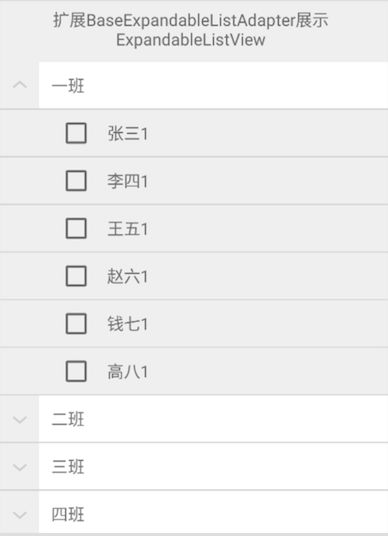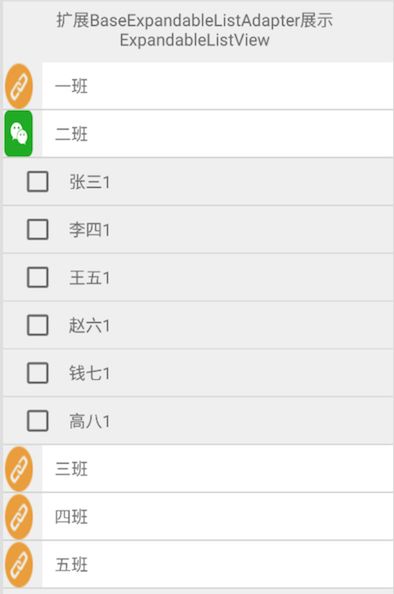1 什么是ExpandableListView?有啥作用?
首先看一张ExpandableListView 的继承关系图:
根据上图可知,ExpandableListView是ListView的子类。而expandable 在英文中的意思是可扩展的,所以ExpandableListView就是一个可以扩展的、有层级的ListView。
ExpandableListView与ListView的区别在于,ExpandableListView 对列表项进行了分组,每个分组中又可以显示具体的子项目。就像QQ中的好友分组,我们登录QQ之后,点击联系人就会显示所有的好友分组,然后点击某个分组,就可以展示这个分组中具体的联系人,这种界面就可以用ExpandableListView 来实现。
2 ExpandableListAdapter
根据上面的 “ExpandableListView 的继承关系” 图可以看出,ExpandableListView本质是一个AdapterView,既然是AdapterView,那么在展示数据的时候就需要使用到Adapter ——在展示ExpandableListView 的数据时使用就是ExpandableListAdapter。
ExpandableListAdapter的继承关系如下图:
通常我们在展示ExpandableListView 的数据时,使用比较多的方式及adapter是:
- 直接自定义Adapter继承BaseExpandableListAdapter.
这种方式的关键是实现四个方法:getCroupCount() 返回组的数量;getCroupView() 返回组的view对象;getChildCount() ,返回某组的子View数量; getChildView() 返回某组中的子view.
- 使用SimpleExpandableListAdapter将两个List集合包装成ExpandableListAdapter
- 使用SimpleCursorTreeAdapter 将Cursor中的数据包装成SimpleCursorTreeAdapter
3 ExpandableListView的几个重要属性及方法
(1)XML属性
由于ExpandableListView 继承自ListView,所以ListView 可用的属性,ExpandableListView 也可以使用,除此之外,还有如下属性(这里只列举2个属性,其他的可以自己查看文档
https://developer.android.google.cn/reference/android/widget/ExpandableListView.html
1) android:groupIndicator 和android:childIndicator
- android:groupIndicator
组指示器。取值可以是任意的Drawable对象。显示在 该分组的最左侧。如果不设置的话,默认是一个向下的箭头,点击展开内容之后会变成向上的箭头。如下图:
- android:childIndicator
子条目指示器。取值可以是任意的Drawable 对象。显示在分组中的每一个 子条目 的最左侧。没有默认图标。
2) 如何更改indicator
如果你想更改 groupIndicator 或者 childIndicator , 可以将值设置成一个selector。具体如下:
运行效果如下:
3)设置和更改indicator时的注意事项:
A
默认情况下,指示器会覆盖组条目内容,就向下图中的这个样子。为了避免这种情况,我们就需要手动的在布局文件中或者代码中将 组条目向右移,以保证条目内容不被覆盖。
B
如果想取消 默认的 gropIndicator,可以将它赋值为"@null",即:android:groupIndicator="@null"。这样就不会再显示groupIndicator了
C
替换默认indicator时,我们使用了一个selector,在编写这个selector时需要特别注意,我们用的状态是 :state_expanded,这个状态在编写的时候不会自动补全,必须完全手动拼写!!
(2)主要方法及监听器
- collapseGroup( int position)
收起 position 位置的分组
- expandGroup(int position)
展开position位置的分组
- isGroupExpanded(int position)
判断position位置的分组是否展开
- setAdapter(ExpandableListAdapter adapter)
给ExpandableListView 设置适配器
- setOnChildClickListener(OnChildClickListener listener)
设置分组中子条目的点击监听器
- setOnGroupClickListener(OnGroupClickListener listener)
设置分组的点击监听器
- setOnGroupCollapseListener(OnGroupCollapseListener listener)
设置分组收起的监听器
- setOnGroupExpandListener(OnGroupExpandListener listener)
设置分组展开的监听器
4 完整示例代码:
该示例代码的实现的效果是:
- 取消默认的 groupIndicator
- 在组条目末尾自定义 展开/收起 的指示器
- 拦截分组的点击事件
- 默认展开第一个分组
- 处理分组中子条目的点击事件
- 处理分组子条目中的强焦点控件的点击事件(这里加入的是CheckBox)
最终效果gif图:
A ExpandableListViewActivity.java
/**
* Created by CnPeng on 2017/1/21.
*
* 使用BaseExpandableLsitAdapter 展示ExpandableLsitView 的具体内容
*/
public class ExpandableListViewActivity extends AppCompatActivity {
private View.OnClickListener ivGoToChildClickListener;
@Override
protected void onCreate(Bundle savedInstanceState) {
super.onCreate(savedInstanceState);
setContentView(R.layout.activity_expandablelv);
init();
}
private void init() {
final ExpandableListView elv01 = (ExpandableListView) findViewById(R.id.elv_01);
//模拟数据(数组,集合都可以,这里使用数组)
final String[] classes = new String[]{"一班", "二班", "三班", "四班","五班"};
final String[][] students = new String[][]{{"张三1", "李四1", "王五1", "赵六1", "钱七1", "高八1"}, {"张三1", "李四1", "王五1",
"赵六1", "钱七1", "高八1"}, {"张三1", "李四1", "王五1", "赵六1", "钱七1", "高八1"}, {"张三1", "李四1", "王五1", "赵六1", "钱七1",
"高八1"},{}};
//自定义 展开/收起 图标的点击事件。position和 isExpand 都是通过tag 传递的
ivGoToChildClickListener = new View.OnClickListener() {
@Override
public void onClick(View v) {
//获取被点击图标所在的group的索引
Map map = (Map) v.getTag();
int groupPosition = (int) map.get("groupPosition");
// boolean isExpand = (boolean) map.get("isExpanded"); //这种是通过tag传值
boolean isExpand = elv01.isGroupExpanded(groupPosition); //判断分组是否展开
if (isExpand) {
elv01.collapseGroup(groupPosition);
} else {
elv01.expandGroup(groupPosition);
}
}
};
//创建并设置适配器
MyExpandableListAdapter adapter = new MyExpandableListAdapter(classes, students, this,
ivGoToChildClickListener);
elv01.setAdapter(adapter);
//默认展开第一个分组
elv01.expandGroup(0);
//展开某个分组时,并关闭其他分组。注意这里设置的是 ExpandListener
elv01.setOnGroupExpandListener(new ExpandableListView.OnGroupExpandListener() {
@Override
public void onGroupExpand(int groupPosition) {
//遍历 group 的数组(或集合),判断当前被点击的位置与哪个组索引一致,不一致就合并起来。
for (int i = 0; i < classes.length; i++) {
if (i != groupPosition) {
elv01.collapseGroup(i); //收起某个指定的组
}
}
}
});
//点击某个分组时,跳转到指定Activity
elv01.setOnGroupClickListener(new ExpandableListView.OnGroupClickListener() {
@Override
public boolean onGroupClick(ExpandableListView parent, View v, int groupPosition, long id) {
Toast.makeText(ExpandableListViewActivity.this, "组被点击了,跳转到具体的Activity", Toast.LENGTH_SHORT).show();
return true; //拦截点击事件,不再处理展开或者收起
}
});
//某个分组中的子View被点击时的事件
elv01.setOnChildClickListener(new ExpandableListView.OnChildClickListener() {
@Override
public boolean onChildClick(ExpandableListView parent, View v, int groupPosition, int childPosition,
long id) {
Toast.makeText(ExpandableListViewActivity.this, "组中的条目被点击:" + classes[groupPosition] + "的" +
students[groupPosition][childPosition] + "放学后到校长办公室", Toast.LENGTH_SHORT).show();
return false;
}
});
}
}
B 布局文件 activity_expandablelv.xml
C 适配器 MyExpandableListAdapter.java
/**
* Created by CnPeng on 2017/1/21.
*
* 自定义ExpandableListAdapter展示ExpandableListView的内容
*/
public class MyExpandableListAdapter extends BaseExpandableListAdapter {
private String[] classes;
private String[][] stuents;
private Context context;
View.OnClickListener ivGoToChildClickListener;
public MyExpandableListAdapter() {
}
public MyExpandableListAdapter(String[] classes, String[][] stuents, Context context,
View.OnClickListener ivGoToChildClickListener) {
this.classes = classes;
this.stuents = stuents;
this.context = context;
this.ivGoToChildClickListener = ivGoToChildClickListener;
}
@Override
public int getGroupCount() { //组的数量
return classes.length;
}
@Override
public int getChildrenCount(int groupPosition) { //某组中子项数量
return stuents[groupPosition].length;
}
@Override
public Object getGroup(int groupPosition) { //某组
return classes[groupPosition];
}
@Override
public Object getChild(int groupPosition, int childPosition) { //某子项
return stuents[groupPosition][childPosition];
}
@Override
public long getGroupId(int groupPosition) {
return groupPosition;
}
@Override
public long getChildId(int groupPosition, int childPosition) {
return childPosition;
}
@Override
public View getGroupView(int groupPosition, boolean isExpanded, View convertView, ViewGroup parent) {
GroupHold groupHold;
if (convertView == null) {
convertView = LayoutInflater.from(context).inflate(R.layout.item_elv_group, null);
groupHold = new GroupHold();
groupHold.tvGroupName = (TextView) convertView.findViewById(R.id.tv_groupName);
groupHold.ivGoToChildLv = (ImageView) convertView.findViewById(R.id.iv_goToChildLV);
convertView.setTag(groupHold);
} else {
groupHold = (GroupHold) convertView.getTag();
}
String groupName = classes[groupPosition];
groupHold.tvGroupName.setText(groupName);
//取消默认的groupIndicator后根据方法中传入的isExpand判断组是否展开并动态自定义指示器
if (isExpanded) { //如果组展开
groupHold.ivGoToChildLv.setImageResource(R.drawable.delete);
} else {
groupHold.ivGoToChildLv.setImageResource(R.drawable.send_btn_add);
}
//setTag() 方法接收的类型是object ,所以可将position和converView先封装在Map中。Bundle中无法封装view,所以不用bundle
Map tagMap = new HashMap<>();
tagMap.put("groupPosition", groupPosition);
tagMap.put("isExpanded", isExpanded);
groupHold.ivGoToChildLv.setTag(tagMap);
//图标的点击事件
groupHold.ivGoToChildLv.setOnClickListener(ivGoToChildClickListener);
return convertView;
}
@Override
public View getChildView(final int groupPosition, final int childPosition, boolean isLastChild, View convertView,
ViewGroup parent) {
ChildHold childHold;
if (convertView == null) {
convertView = LayoutInflater.from(context).inflate(R.layout.item_elv_child, null);
childHold = new ChildHold();
childHold.tvChildName = (TextView) convertView.findViewById(R.id.tv_elv_childName);
childHold.cbElvChild = (CheckBox) convertView.findViewById(R.id.cb_elvChild);
convertView.setTag(childHold);
} else {
childHold = (ChildHold) convertView.getTag();
}
String childName = stuents[groupPosition][childPosition];
childHold.tvChildName.setText(childName);
childHold.cbElvChild.setOnCheckedChangeListener(new CompoundButton.OnCheckedChangeListener() {
@Override
public void onCheckedChanged(CompoundButton buttonView, boolean isChecked) {
if (isChecked) {
Toast.makeText(context, "条目选中:" + classes[groupPosition] + "的" +
stuents[groupPosition][childPosition] + "被选中了", Toast.LENGTH_SHORT).show();
} else {
Toast.makeText(context, "条目选中:" + classes[groupPosition] + "的" +
stuents[groupPosition][childPosition] + "被取消选中了", Toast.LENGTH_SHORT).show();
}
}
});
return convertView;
}
@Override
public boolean isChildSelectable(int groupPosition, int childPosition) {
return true; //默认返回false,改成true表示组中的子条目可以被点击选中
}
@Override
public boolean hasStableIds() {
return true;
}
class GroupHold {
TextView tvGroupName;
ImageView ivGoToChildLv;
}
class ChildHold {
TextView tvChildName;
CheckBox cbElvChild;
}
}
D 分组的布局 item_elv_group.xml
E 分组中子条目的布局文件 item_elv_child.xml
5 总结:
A
groupIndicator 以及childIndicator 太鸡肋了,直接赋值为 @null 屏蔽掉吧
B
如果列表的条目中有强焦点的控件,如checkBox ,为了避免抢走条目焦点,需要取消他们的焦点:focusale=”false”
C
如果在Adapter中如果想知道当前分组的展开/收起状态,那么可以从 adpater 的 getGroupView() 方法中获取,其中一个参数就是isExpand;如果在activity 等中可以调用 isGroupExpandable(position)
D
setTag(object) 方法中的参数是object类型的,如果需要传递多个信息可以使用map 或者bundle等进行封装,但是bundle中不能封装view对象
E
ExpandListView 类中的 collapseGroup(position) 、expandGroup(position) 作用分别是收起 、展开 position位置的分组。
F
监听分组的展开/收起事件时使用 onGroupExpandListener();
G
监听分组的点击事件时使用 onGroupClickListener() , 该监听器默认返回false, 会去处理分组的展开/收起。如果我们点击后不需要处理 展开/收起 的事件就返回true.(返回true 表示事件被拦截)
H
在处理自定义的 groupIndicator 的点击事件时,使用到了回调。相关知识可以参考我的另一篇文章:http://www.jianshu.com/p/eb226c340450





